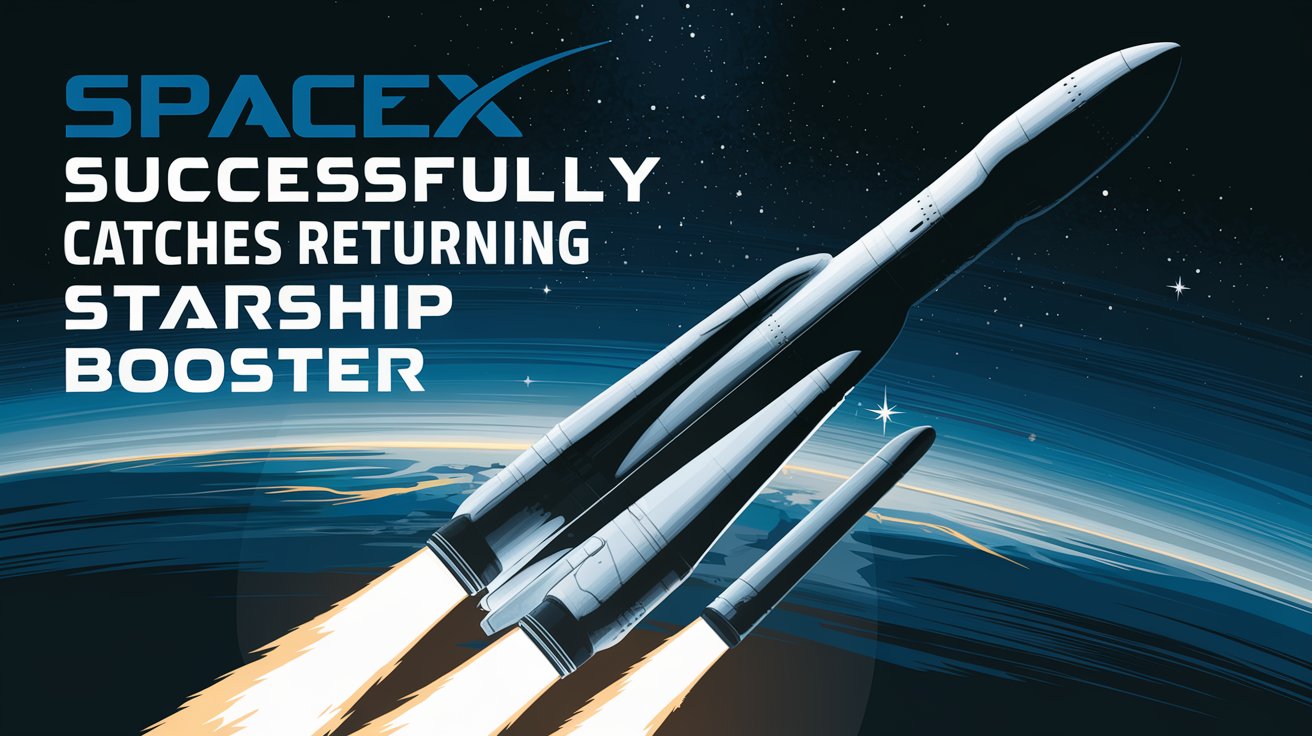SpaceX, the private aerospace company founded by Elon Musk, has once again pushed the boundaries of space exploration and rocket technology with its successful catch and recovery of a Starship booster. This achievement marks a significant milestone in the development of reusable rocket systems, advancing SpaceX’s mission to make space travel more cost-effective, sustainable, and ultimately accessible to humanity. The ability to successfully catch and recover a booster represents a critical step forward in realizing Musk’s vision of interplanetary exploration, including the ambitious goal of establishing a human settlement on Mars.
The recovery of a booster after launch is not just a technical feat; it represents a major breakthrough in reducing the cost and environmental impact of space missions. Reusability has always been at the core of SpaceX’s long-term strategy, and the successful catch of the Starship booster signifies that the company is steadily refining the reusable rocket systems necessary for interplanetary travel. Let’s take a deeper look at how SpaceX achieved this historic milestone, the technology behind it, and the broader implications for the future of space exploration.
The Starship Program: A Game-Changer in Space Exploration
At the center of this achievement is Starship, SpaceX’s next-generation spacecraft designed to carry humans and cargo beyond Earth’s orbit. Starship is intended to serve a variety of missions, including lunar landings, Mars colonization, and even long-distance space tourism. The entire Starship system consists of two stages: the Starship spacecraft, which sits atop the Super Heavy booster. While the Starship spacecraft is the part that will carry astronauts or cargo, the Super Heavy booster is responsible for providing the necessary thrust to propel the Starship into space.
Both the Starship and the Super Heavy booster are designed to be fully reusable, which is key to SpaceX’s vision of lowering the cost of space missions. Traditional rockets are largely expendable; after launching, their boosters fall into the ocean or burn up in the atmosphere, making each launch a costly endeavor. By contrast, SpaceX aims to recover and reuse every component of the Starship system, dramatically reducing the cost per launch.
The successful catch and recovery of the Super Heavy booster is a major step toward this goal. Much like SpaceX’s Falcon 9 rocket, which has pioneered booster landings on both land and sea-based platforms, the Starship booster recovery system is designed to bring the booster back to Earth after it has completed its mission, ready for refurbishment and reuse.
How the Booster Catch System Works
SpaceX’s booster recovery system is nothing short of revolutionary. In previous rocket systems, recovery typically involved landing the booster vertically on a platform, such as SpaceX’s famous droneships used for Falcon 9 recoveries. However, with the Starship system, SpaceX has opted for a different approach—catching the booster mid-air using specialized infrastructure at the launch site.
This approach eliminates the need for landing legs on the booster, further reducing its weight and complexity. The innovative catch system is part of SpaceX’s Mechazilla, a massive robotic tower equipped with mechanical arms designed to catch the returning booster as it descends. The booster is guided back to the launch tower by precision thrusters and aerodynamic surfaces, where the mechanical arms reach out to catch it, stabilize it, and bring it back into position for its next flight.
The booster catch system is a critical part of SpaceX’s vision for rapid reusability. By eliminating the need for landing legs and using the catch system instead, the company aims to dramatically shorten the turnaround time between launches. In theory, once the booster is caught, it can be inspected, refueled, and readied for another mission in a matter of hours or days, rather than the weeks or months typically required for rocket refurbishment.
The Challenges of Reusability
While the concept of reusability may seem straightforward, the technical challenges involved are immense. Rockets must endure extreme forces during both launch and reentry. High temperatures generated during atmospheric reentry can cause significant damage to rocket components, and ensuring that these components can withstand multiple flights requires sophisticated engineering.
One of the key challenges SpaceX has faced is the safe and precise landing of the booster. Even with advanced guidance systems and aerodynamic controls, landing a booster is a delicate operation. With the Starship booster catch system, SpaceX has introduced an entirely new level of precision, requiring the booster to align perfectly with the robotic arms of the Mechazilla tower during descent. This is no easy feat, as even slight deviations in trajectory could lead to a failed recovery attempt.
In addition to the technical hurdles, reusability presents logistical challenges. Each booster must be carefully inspected after landing to ensure that all components are in working order and that there is no structural damage. Even with the most advanced materials and engineering practices, wear and tear will accumulate over time, and booster components may eventually need to be replaced or refurbished.
Nevertheless, SpaceX’s successful track record with the Falcon 9 booster recovery program—where boosters have been reused up to a dozen times—provides a solid foundation for the development of the Starship booster recovery system. The experience gained from years of Falcon 9 operations has allowed SpaceX engineers to refine their techniques, optimize booster design, and improve the durability of critical components.
Why This Achievement Matters
The successful catch and recovery of the Starship booster have far-reaching implications for the future of space exploration. First and foremost, it represents a major milestone in SpaceX’s ongoing quest to reduce the cost of space missions. By making rockets fully reusable, SpaceX is able to cut the cost of launching satellites, cargo, and even humans into space by a significant margin. This is a crucial development as humanity looks toward more ambitious space missions, such as sending astronauts to Mars.
The reduced cost of space access also opens the door for a broader range of missions. Commercial spaceflight, scientific research, and space tourism could all become more affordable, allowing more players to enter the space industry. Governments, private companies, and research institutions could take advantage of lower launch costs to deploy more satellites, conduct more research, and explore more distant regions of space.
Furthermore, SpaceX’s achievements in reusability are critical for the long-term sustainability of space exploration. As we look beyond Earth, the ability to reuse spacecraft and boosters will be essential for establishing a permanent human presence on other planets. Musk’s vision of a self-sustaining colony on Mars hinges on the ability to launch regular missions to and from the planet, something that would be prohibitively expensive without reusable spacecraft.
The success of the Starship booster recovery also solidifies SpaceX’s leadership in the commercial space industry. While other companies, such as Blue Origin and Rocket Lab, are also working on reusable rockets, SpaceX has consistently been at the forefront of innovation. The ability to catch and recover a booster represents a significant technological leap that sets SpaceX apart from its competitors.
What’s Next for SpaceX?
The successful recovery of the Starship booster is just one step in SpaceX’s ambitious development plan for the Starship program. The company has already made significant progress in building and testing the Starship spacecraft itself, which is designed to carry humans and cargo to destinations such as the Moon, Mars, and beyond.
One of the next major milestones for SpaceX will be conducting a full-scale orbital test flight of the complete Starship system, including both the Starship spacecraft and the Super Heavy booster. This test will demonstrate the ability of the Starship system to launch, reach orbit, and return safely to Earth. If successful, it will pave the way for crewed missions, lunar landings, and ultimately missions to Mars.
In parallel with the development of Starship, SpaceX is also working on a range of other projects that are critical to its long-term goals. These include the Starlink satellite network, which aims to provide global broadband coverage, and the Lunar Gateway project, a collaboration with NASA to build a space station orbiting the Moon.
Conclusion: A New Era of Space Exploration
The successful catch and recovery of the Starship booster mark a significant turning point in the history of space exploration. SpaceX’s achievement is a testament to the company’s relentless pursuit of innovation and its commitment to making space more accessible to humanity. By advancing reusable rocket technology, SpaceX is not only reducing the cost of space travel but also laying the groundwork for future missions to the Moon, Mars, and beyond.
As we look to the future, the implications of this breakthrough are profound. Cheaper and more sustainable space access could unlock new opportunities for scientific discovery, economic growth, and human exploration. SpaceX’s vision of a multiplanetary future is becoming more tangible with each technological leap, and the successful recovery of the Starship booster is one more step toward turning that vision into reality.
With more milestones on the horizon, the space industry—and humanity as a whole—stands on the cusp of an exciting new era. As SpaceX continues to push the boundaries of what is possible, one thing is clear: the future of space exploration has never been more promising.





